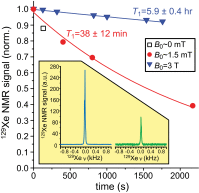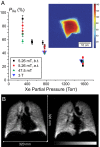Near-unity nuclear polarization with an open-source 129Xe hyperpolarizer for NMR and MRI
- PMID: 23946420
- PMCID: PMC3761567
- DOI: 10.1073/pnas.1306586110
Near-unity nuclear polarization with an open-source 129Xe hyperpolarizer for NMR and MRI
Abstract
The exquisite NMR spectral sensitivity and negligible reactivity of hyperpolarized xenon-129 (HP(129)Xe) make it attractive for a number of magnetic resonance applications; moreover, HP(129)Xe embodies an alternative to rare and nonrenewable (3)He. However, the ability to reliably and inexpensively produce large quantities of HP(129)Xe with sufficiently high (129)Xe nuclear spin polarization (P(Xe)) remains a significant challenge--particularly at high Xe densities. We present results from our "open-source" large-scale (∼1 L/h) (129)Xe polarizer for clinical, preclinical, and materials NMR and MRI research. Automated and composed mostly of off-the-shelf components, this "hyperpolarizer" is designed to be readily implementable in other laboratories. The device runs with high resonant photon flux (up to 200 W at the Rb D1 line) in the xenon-rich regime (up to 1,800 torr Xe in 500 cc) in either single-batch or stopped-flow mode, negating in part the usual requirement of Xe cryocollection. Excellent agreement is observed among four independent methods used to measure spin polarization. In-cell P(Xe) values of ∼90%, ∼57%, ∼50%, and ∼30% have been measured for Xe loadings of ∼300, ∼500, ∼760, and ∼1,570 torr, respectively. P(Xe) values of ∼41% and ∼28% (with ∼760 and ∼1,545 torr Xe loadings) have been measured after transfer to Tedlar bags and transport to a clinical 3 T scanner for MR imaging, including demonstration of lung MRI with a healthy human subject. Long "in-bag" (129)Xe polarization decay times have been measured (T1 ∼38 min and ∼5.9 h at ∼1.5 mT and 3 T, respectively)--more than sufficient for a variety of applications.
Keywords: hyperpolarization; laser-polarized xenon; lung imaging; optical pumping.
Conflict of interest statement
The authors declare no conflict of interest.
Figures





References
-
- Goodson BM. Nuclear magnetic resonance of laser-polarized noble gases in molecules, materials, and organisms. J Magn Reson. 2002;155(2):157–216. - PubMed
-
- Mugler JP, 3rd, et al. MR imaging and spectroscopy using hyperpolarized 129Xe gas: Preliminary human results. Magn Reson Med. 1997;37(6):809–815. - PubMed
-
- Leawoods JC, et al. Hyperpolarized He-3 gas production and MR imaging of the lung. Concepts Magn Reson. 2001;13(5):277–293.
-
- Möller HE, et al. MRI of the lungs using hyperpolarized noble gases. Magn Reson Med. 2002;47(6):1029–1051. - PubMed
Publication types
MeSH terms
Substances
Grants and funding
LinkOut - more resources
Full Text Sources
Other Literature Sources
Medical
Research Materials
Miscellaneous

